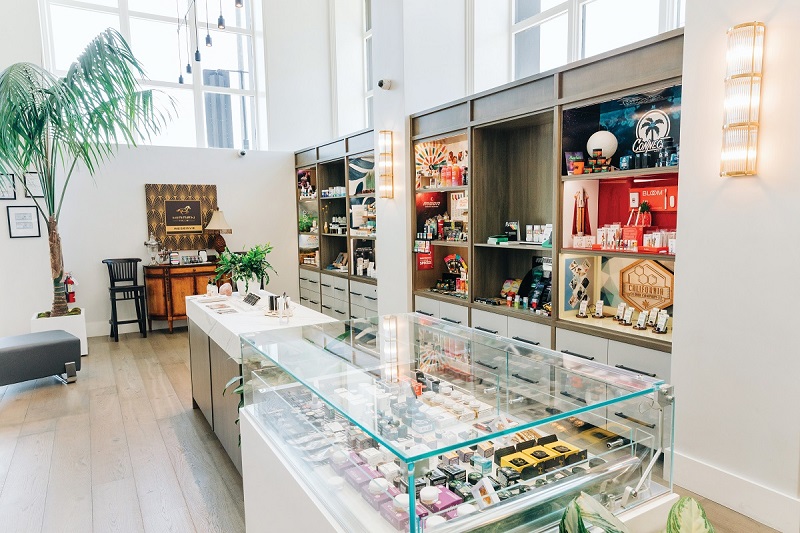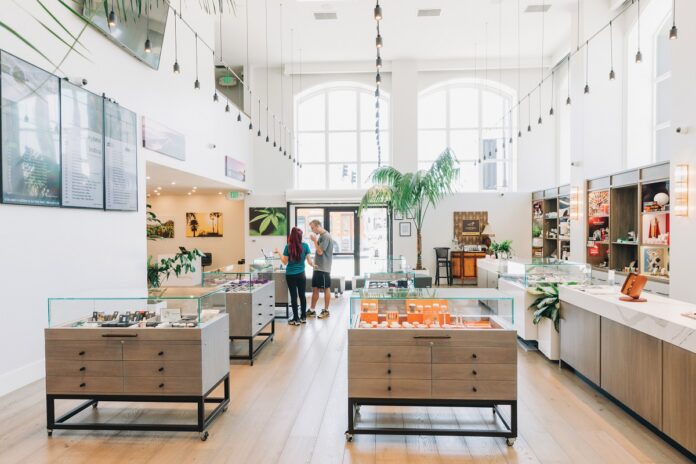As we settle into 2021, cannabis’s essential designation is old news. Likewise, cannabis consumers’ rapid shift toward online pre-orders, curbside pickup, and delivery is well-documented at this point, with sales data sliced and diced during industry panels and in management team meetings.
What those data do not provide, however, is a crystal ball for how consumer behaviors will shift as we move into a fully vaccinated, post-pandemic world.
Throughout the cannabis industry, there’s widespread agreement many of the consumer habits developed during the pandemic are here to stay, even as the pandemic recedes. This perspective makes sense when looking more broadly at the shift to online shopping across all retail sectors. The pandemic merely allowed cannabis to catch up once regulations were amended to allow for safer shopping.
Big questions remain, though, as we look to the future of cannabis retail. Will there be a rush of lockdown-weary, Zoom-fatigued consumers who enthusiastically return to in-store shopping once the pandemic recedes? Or will the convenience of online shopping win out, with dispensaries fully morphing into showrooms or experiential venues?
An omnichannel world
Omnichannel has been around for more than a decade, with retail industry publications discussing the trend as early as 2010. For cannabis, however, omnichannel is a brave new world accelerated by pandemic-driven regulatory changes allowing flexibility in how consumers shop for flower, concentrates, edibles, and other products.
Omnichannel integrates the retail experience, taking the in-store experience and seamlessly translating it to the virtual space. Imagine the customer standing at a display counter, browsing products displayed by effect and asking the budtender questions. Now, imagine the dispensary’s online customer tapping into the same experience through an online ordering site, with products organized by effect and a budtender available via live chat to explain, educate, and offer product alternatives. Taken together, those two scenarios illustrate an omnichannel merchandising approach.
While many cannabis retailers are struggling to catch up and build an omnichannel strategy, consumers are already there, expecting the same convenient shopping experiences at dispensaries as they enjoy when purchasing other consumer products.
Tate Behning, vice president of marketing at Colorado-based Terrapin, described the upside for cannabis retailers who develop a robust digital e-commerce strategy like that experienced in other retail sectors. Cannabis operators will find “a lot of opportunity to tie in-store and online experiences together, create more engagement and awareness through all the channels, and end up with more loyal customers,” he said. “On the other hand, retailers that have not created a good online experience or engaged customers through their digital channels will miss out on a lot of sales.”
In-store shopping will survive
A curious thing happened in the second half of 2020. Consumers began returning to shopping centers and malls, with foot traffic approaching pre-pandemic levels by the end of the year according to S&P Global Market Intelligence data. However, analysts also noted longer-term trends continued to reflect decreasing year-over-year shopping-mall foot traffic as online commerce gained a larger market share. So, consumers are back—but not really. These data reflect the push and pull of changing consumer behaviors in the rapidly evolving retail landscape.
While online retail offers convenience, in-store shopping offers the connection and discovery many consumers crave. This is especially true in the cannabis sector, where budtender interactions are core to consumers’ shopping experience. Also, the dispensary visit itself remains a fun, novel experience for consumers, especially in locations that recently legalized recreational use.
Even in mature markets, immersive in-store experiences, like those found at The Artist Tree in West Hollywood, California, kept bringing customers through the doors during the pandemic. The Artist Tree features art and cannabis in a gallery-like setting created to cultivate community, earning the dispensary the 2020 Clio Cannabis Award for best retail design.
“This past year, people really wanted to get out of their homes and visit someplace where they could enjoy themselves and experience something different,” said Tommy Quicksilver, vice president of marketing and business development at The Artist Tree. “I anticipate we will see foot traffic remain steady or even continue to grow in 2021, since people understand the rules around in-person shopping by this point.”
Once cannabis was deemed essential, The Artist Tree quickly developed clear, visible rules about capacity limits, cleanliness, and safety. Beyond its bottom-line assurance to customers regarding store safety, The Artist Tree also benefited from having knowledgeable staff who had built trusted relationships with customers, as well as exclusive product offerings not found elsewhere.
“‘Sterile’ used to be a bad word for an environment, but by simplifying our environment we can now convey cleanliness and safety.”
—Tate Behning, VP of marketing, Terrapin
“We get resounding endorsements for our team’s knowledge and ability to help people,” Quicksilver said. “And beyond our people, we have an incredible assortment of products and visual art people love to see in person.”
Other cannabis retailers saw a drop in foot traffic during the early months of the pandemic as the public scrambled to understand the risks associated with in-person activities. Once consumers understood how to minimize risks, they returned to retailers who could demonstrate they were taking the pandemic seriously.
Ajoya dispensary in Louisville, Colorado, saw consumers significantly shift to online ordering in March and April, with a return to in-store shopping over the summer. Much like The Artist Tree, Ajoya credits the return to the high-touch customer service provided by its budtenders. However, Ajoya marketing consultant Kate Heckman anticipates more consumers will shift to online shopping in the future as part of a larger trend toward convenience.
“As digital platforms become more robust, customers will have more confidence ordering online,” she said. “Also, with the upcoming rollout of adult-use delivery in Colorado, we expect online orders will increase for that reason as well.”
Emerging trends for in-store merchandising
For retailers looking to build foot traffic in 2021, understanding the customer base, the brand’s value proposition, and broader retail trends will become more important than ever. Across all sectors, simplicity will be king, with retailers embracing simple, uncluttered store layouts and displays.
“‘Sterile’ used to be a bad word for an environment, but by simplifying our environment we can now convey cleanliness and safety,” said Terrapin’s Behning. “We still, however, want the store environment to feel welcoming, because more than 75 percent of our customers are still coming into stores.”
The Artist Tree’s Quicksilver also sees a trend toward simplifying. “There are a lot of merchandising tactics in both cannabis and traditional retail that go overboard and try to do too much,” he said. “What I’ve found works really well in our store is to bring a less-is-more mentality. We like to keep it simple and present a concise picture of who the brand is, what the product is, and what the customer is getting when they buy it.”
Ajoya embraced a modern, minimalist aesthetic from its beginning. Now, the store is turning its attention to store layout that reflects customer segmentation. “Some of our customers want an expedited experience, while others are looking for a more leisurely interaction chatting with budtenders, browsing different products, and shopping for soft goods,” Heckman said. “Our goal is to be able to merchandise the store in a way that serves both of these types of consumers.”
Liz Connors, director of analytics at Headset, sees another merchandising trend emerging in 2021 and beyond. “I think we’ll see stores start to negotiate more with brands for preferential shelf space,” she said. “Some states allow slotting fees. In other markets, brands and stores will have to be more creative, with brands offering discounts to stores for products that receive preferential space.”
Retail events in a hybrid world
In-person events always have been crucial to product discovery and promotion within the cannabis industry. However, in 2020 the pandemic pushed everyone online, with virtual events replacing concerts, 420 parties, and in-person holiday celebrations.
Many large in-person events remain in limbo for 2021, and retailers are understandably cautious about drawing big crowds to in-store events. Likewise, the public has expressed mixed feelings about traveling and gathering in person while COVID-19 is still circulating, even as lockdowns are lifted and vaccines become more widely available.
What will the event landscape look like? Forbes magazine predicted 2021 will be the year of the hybrid event, with smaller in-person audiences joined by virtual attendees. Over the past year, the public became more familiar with interactive online events hosted on Zoom, YouTube, or Twitch. People will expect these options to remain available even as venues open back up.
Hybrid events provide added benefits for businesses as well, creating a built-in backup plan should new pandemic-related restrictions suddenly come into effect.
Public events always have been central to The Artist Tree, which invests heavily in creative experiences that go beyond retail. Coming into 2020, the dispensary had planned a series of in-person comedy shows, concerts, and art events, as well as the launch of a social consumption lab. When pandemic restrictions took effect, The Artist Tree channeled many of those plans into the virtual realm to stay connected with the community.

“Community is such a big part of our brand,” Quicksilver said. “Community goes hand-in-hand with cannabis and creativity, which is one of our core pillars. Being able to engage with our community across digital platforms, showcase our brand, and build partnerships has been a great experience.”
While community connection is the primary focus of The Artist Tree’s live streams, the format proved effective for introducing new products to consumers as part of the event. “We recently did a live stream in conjunction with a new 710 Labs x dosist collab[orative] product launch, which we were one of the exclusive retailers for. During the online event, the DJ showcased the product and promoted it via her channels, letting her followers know they could find it at The Artist Tree,” Quicksilver said. “The event gave us the chance to connect with consumers and provide an experience as part of the product launch that we would not have been able to provide in-store right now.”
The Artist Tree also has hosted virtual wellness education and programs, showcasing how a specific SKU from a brand can elevate and enhance yoga, meditation, and other practices. The brand hosted wellness-focused events on Zoom so people at home could set up their computers and participate virtually while consuming.
“It’s been a unique challenge to navigate the virtual world, but I believe we’ve handled it well,” Quicksilver said. “Also, it helps us build for the future when we bring these programming initiatives back into the real world—hopefully soon.”
Text messaging: familiar but risky
Compared to virtual concerts and live-streamed yoga, SMS text marketing has been around for a while, yet it remains a powerful tool for product discovery and customer engagement. In 2020, 75 percent of consumers who own mobile phones were okay with receiving marketing messages after opting in for the service, according to a report from TechJury. Text message open rates average 98 percent, and they have a 209-percent higher response rate than phone, email, or Facebook. Moreover, consumers redeem SMS-delivered coupons ten times more often than other types of coupons.
Ajoya’s experience with texting opted-in customers has been overwhelmingly positive. “Our text open rates are really high, and we see a quick response from customers,” Heckman said. “We built text messaging into our content calendar. Also, if we have excess inventory or want to promote a flash sale, we can quickly reach out to customers via text and get a response.”
While text-based marketing may sound like an easy solution, it’s not cheap, and retailers need to understand the landscape before implementing a text marketing strategy. Businesses should be savvy to mobile carriers’ content filters, which screen for words related to cannabis that might indicate illicit drug sales. Optimizing text copy by using words like “tasty treat” instead of “edible” can help improve the delivery rate, noted Heckman.
Retailers also need to make sure texts comply with Telephone Consumer Protection Act (TCPA) regulations designed to limit telemarketer solicitations and spam. The rules, administered by the Federal Trade Commission, require businesses to get two forms of consent and offer a clear opt-out option for consumers who change their mind after signing up. Failing to follow the FTC’s regulations can result in steep fines, lawsuits, and hefty court settlements, as several cannabis businesses recently discovered. The Cellular Telecommunications and Internet Association (CTIA) offers best practices and suggestions for keeping SMS marketing within federal guidelines.
Bringing budtenders online
As consumers shifted to online ordering, cannabis retailers also have explored ways to extend the budtender experience to the virtual space. Some retailers have integrated chatbots into online menus to answer basic questions about store hours, accepted payment types, and pickup options. Other businesses, including Ajoya and Terrapin, are taking things a step further and making budtenders available in real-time to customers who browse online menus during store hours.
“Ajoya has a high-touch customer service experience at all interaction points,” Heckman said. “We knew that as our customers moved toward online ordering, they would have questions about products and the ordering process itself, and we wanted to get that information to them as seamlessly and quickly as possible.”
Heckman also noted today’s consumers avoid making phone calls to get answers to questions, making online support more valuable than ever.
Budtenders were immediately on board with Ajoya’s plan to offer real-time chat support and had the necessary skills for the service to launch quickly. “Our budtenders are digital natives,” Heckman said. “They understand that without visual cues, the tone and message construction on chat take on increased importance.”
Ajoya coaches its budtenders about ways to build rapport, as well as the importance of circling back to make sure customers’ questions are answered completely. Management also added chat opening and closing procedures to the store’s standard operating procedures as part of normal daily operations. However, the retailer eschews scripted chat responses, instead relying upon budtenders’ knowledge and enthusiasm to deliver authentic interactions and product recommendations.
“Cannabis is such a high-touch purchasing experience. With changes in retailing, like the move away from labels like ‘indica’ and ‘sativa’ toward effects categories like ‘unwind’ or ‘settle,’ many people have questions.”
—Kate Heckman, marketing consultant, Ajoya
The questions that come in through Ajoya’s chat run the gamut, from customers asking how to set up AeroPay accounts for contactless payment to inquiries about flower and concentrates in stock, as well as specific product questions. The purpose of the chat is not to upsell but to engage and educate.
“Our main goal with real-time chat is to help customers build confidence with their online shopping,” Heckman said. “Cannabis is such a high-touch purchasing experience. With changes in retailing, like the move away from labels like ‘indica’ and ‘sativa’ toward effects categories like ‘unwind’ or ‘settle,’ many people have questions. With the chat, we’re able to support learning about terpene profiles and help customers find the products that best fit their needs.”
In the future, Heckman anticipates developing basic training and a dedicated customer support function to handle incoming chat, email, and phone calls. She envisions a centralized approach could give staff easier access to details from a customer’s previous encounters, eliminating the need for the customer to repeat their preferences during each visit.
Heckman also believes machine learning will play a prominent role in the future of online shopping in the cannabis space, delivering personalized learning and product discovery based on a customer’s past purchases and product reviews.
Optimizing online menus to guide product discovery
For many retailers, on-demand, real-time chat may not be feasible at this time. However, other ways exist to improve the online shopping experience, even within the limited iFrame online menu apps used by most retailers.
Headset’s Connors provided the following tips to guide online shoppers and drive product discovery:
- Make sure the website is easy to find and incorporates an easy-to-find menu.
- Consider ways to categorize products by effect within larger categories. For example, within the edibles category, a retailer might include sections or tags for “social,” “calm,” and “unwind.”
- Add metadata to menus, including short descriptions of products to help customers without requiring budtender input.
Retailers’ online menus should be core to their retail strategy, not an afterthought. For example, Terrapin put significant resources into improving its virtual menus this year as customers shifted to online pre-ordering.
“We’ve viewed this as an opportunity to further educate our customers,” Behning said. “Just like Amazon places a high priority on product pictures and descriptions, we’ve worked much harder to ensure our data is accurate, the pictures are attractive, and the descriptions are thorough so customers understand what they are buying.”
The Terrapin menu sticks with familiar “sativa,” “indica,” and “hybrid” labels across product categories; however, verified customer reviews include visual tags for activities and feelings associated with specific products, along with customers’ detailed product reviews.
Terrapin also added featured products to the top row of its online menu and simplified deals such as percent discounts, understanding e-commerce requires different strategies from in-store promotions.
Preparing for an uncertain year ahead
Analysts across all sectors are scrutinizing data for clues about how consumer habits may change in 2021, but many unknowns remain. From the prospect of economy-boosting stimulus packages to the specter of additional lockdowns or future political unrest, divergent factors may come into play that directly impact retail sales figures.
However, if 2020 was any indication, cannabis retail is resilient. Moreover, unlike other sectors, there is no goliath Walmart of weed—yet. Cannabis retailers who fully embrace an omnichannel approach to merchandising likely will reap substantial rewards in both sales and customer loyalty, regardless how the year plays out.












